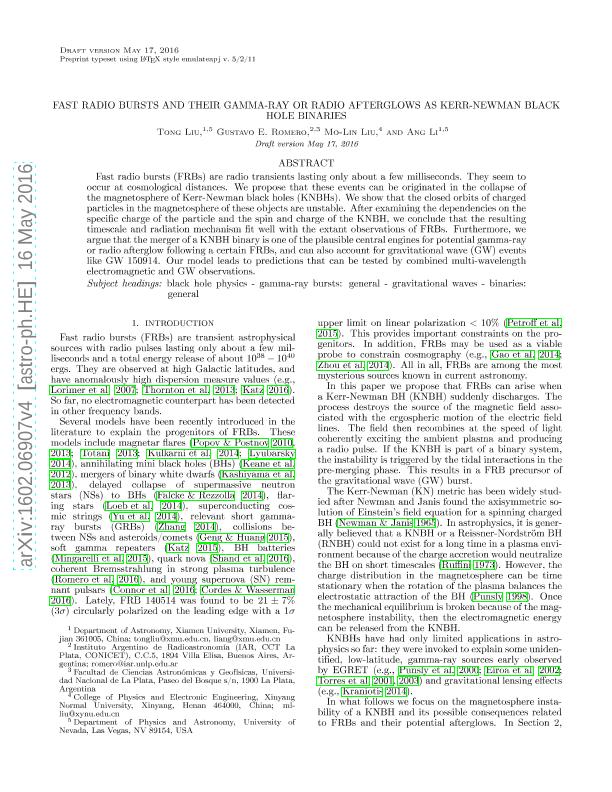Mostrar el registro sencillo del ítem
dc.contributor.author
Liu, Tong
dc.contributor.author
Romero, Gustavo Esteban

dc.contributor.author
Liu, Mo-Lin
dc.contributor.author
Li, Ang
dc.date.available
2017-10-04T14:34:33Z
dc.date.issued
2016-07
dc.identifier.citation
Liu, Tong; Romero, Gustavo Esteban; Liu, Mo-Lin; Li, Ang; Fast radio bursts and their gamma-ray or radio afterglows as Kerr-Newman black hole binaries; IOP Publishing; Astrophysical Journal; 826; 1; 7-2016; 1-6
dc.identifier.issn
0004-637X
dc.identifier.uri
http://hdl.handle.net/11336/25853
dc.description.abstract
Fast radio bursts (FRBs) are radio transients lasting only about a few milliseconds. They seem to occur at cosmological distances. We propose that these events can originate in the collapse of the magnetospheres of Kerr-Newman black holes (KNBHs). We show that the closed orbits of charged particles in the magnetospheres of these objects are unstable. After examining the dependencies on the specific charge of the particle and the spin and charge of the KNBH, we conclude that the resulting timescale and radiation mechanism fit well with extant observations of FRBs. Furthermore, we argue that the merger of a KNBH binary is a plausible central engine for the potential gamma-ray or radio afterglow following certain FRBs and can also account for gravitational wave (GW) events like GW 150914. Our model leads to predictions that can be tested by combined multi-wavelength electromagnetic and GW observations.
dc.format
application/pdf
dc.language.iso
eng
dc.publisher
IOP Publishing

dc.rights
info:eu-repo/semantics/openAccess
dc.rights.uri
https://creativecommons.org/licenses/by-nc-sa/2.5/ar/
dc.subject
Binaries
dc.subject
Black Hole Physics
dc.subject
Gamma Ray Bursts
dc.subject
Gravitational Waves
dc.subject.classification
Otras Ciencias Físicas

dc.subject.classification
Ciencias Físicas

dc.subject.classification
CIENCIAS NATURALES Y EXACTAS

dc.title
Fast radio bursts and their gamma-ray or radio afterglows as Kerr-Newman black hole binaries
dc.type
info:eu-repo/semantics/article
dc.type
info:ar-repo/semantics/artículo
dc.type
info:eu-repo/semantics/publishedVersion
dc.date.updated
2017-09-01T18:27:23Z
dc.journal.volume
826
dc.journal.number
1
dc.journal.pagination
1-6
dc.journal.pais
Estados Unidos

dc.description.fil
Fil: Liu, Tong. University Of Nevada, Las Vegas; Estados Unidos. Xiamen University; China
dc.description.fil
Fil: Romero, Gustavo Esteban. Provincia de Buenos Aires. Gobernación. Comisión de Investigaciones Científicas. Instituto Argentino de Radioastronomía. Consejo Nacional de Investigaciones Científicas y Técnicas. Centro Científico Tecnológico Conicet - La Plata. Instituto Argentino de Radioastronomía; Argentina. Universidad Nacional de la Plata. Facultad de Ciencias Astronómicas y Geofísicas; Argentina
dc.description.fil
Fil: Liu, Mo-Lin. Xinyang Normal University; China
dc.description.fil
Fil: Li, Ang. Xiamen University; China. University Of Nevada, Las Vegas; China
dc.journal.title
Astrophysical Journal

dc.relation.alternativeid
info:eu-repo/semantics/altIdentifier/doi/http://dx.doi.org/10.3847/0004-637X/826/1/82
dc.relation.alternativeid
info:eu-repo/semantics/altIdentifier/arxiv/https://arxiv.org/abs/1602.06907v4
Archivos asociados
